Having a solid content strategy is a sure-fire way to get a competitive advantage. There is so much content created blindly without purpose, and this approach doesn't set you up for success.
Relying on “finger in the air” blog content, as an example, will not help you to create content that drives the results you need. This is one of the main reasons marketers who don't see an impact from their content marketing efforts give up and stop allocating resources.
However, content can mean big money for your business. In fact, “ the Content Marketing Institute's digital content marketing stats show that 72% of marketers say that content has increased the number of leads that they generate.”
When you are developing a solid content strategy, you want to create different types of content that catches users at the right step of the sales funnel. From creating top-of-the-funnel content to end-of-the-funnel content, you will find that certain types of content will create potential customers that you can lead through the sales funnel.
In this guide, we will show you how to develop a content strategy that sets you up for success and provides you with a clear roadmap for creating and publishing content that produces measurable results.
Specifically, we'll look at:
What Is a Content Strategy? Why You Need to Develop a Content Marketing Strategy An 8 Step Template For Creating a Content Strategy 1. Setting Your Goals and KPIs 2. Researching Your Audience Personas 3. Conducting a Content Audit 4. Prioritizing Optimizing Existing Content 5. Finding Content and Keyword Gaps 6. Planning New Content 7. Crafting a Content Distribution and Promotion Strategy 8. Measuring SuccessAs you move through the guide, record any notes or findings with our content strategy template.
What Is a Content Strategy?
You must understand the difference between strategy and tactics when putting together a content strategy. Think about it this way:
Goals: What you want to achieveStrategy: Your plan to achieve this goalTactics: How you are going to execute this plan
If you have not set your goals, you will struggle to create a strategy template. And if you do not create a plan, how can you map out what you need to do to execute it?
You need to know where you are now, where you are going, and how you will get there.
As Re: signal's Kevin Gibbons has previously commented on the importance of taking a strategy-first approach, “If you don't know where you're going, don't complain about where you end up.”
Applying this to content marketing, a content strategy template helps you to figure out what content you need to create and to be able to justify why you are making it.
Why You Need to Develop a Content Marketing Strategy
You must be taking the time to plan a content marketing strategy, are regularly reviewing it and changing things up as needed, and understand how your content marketing strategy is going to meet your business' goals.
A well-developed content strategy helps you to:
Plan a content calendar based on opportunities that you have identified.
Keep sight of what your competitors are doing so that you can figure out how to do something better.
Keep focused on consistently creating content that aligns with your goals.
Use the right formats and distribution channels to place your content in front of your audience.
Know precisely who this audience is and the content that they want to consume.
Content marketing as a tactic does not just sit in its own silo. Done right, a great content strategy template can help you to:
Rank higher on the SERPs for your target keywords and drive consistent growth in organic search traffic.
Drive engagement across your social media channels and integrate with your social media strategy.
Position you as experts and specialist thought-leaders in your industry.
Turn your site's browsers into buyers.
If you want to succeed online, you can't ignore the power of content marketing.
An 8 Step Template For Creating a Content Strategy
Success starts with creating a content strategy, but knowing where to begin is often the most challenging part.
And to help you out, we have put together a proven eight-step template framework that you can use as a starting point. You can also use the content strategy template to record findings as you complete the framework.
1. Setting Your Goals and KPIs
It all starts with setting goals and KPIs. If you have not selected your goals, you have no strategy. But what goals should you be setting for your content?
This, to some extent, depends upon your broader marketing goals, but could include things like:
Drive an increase in traffic Drive an increase in conversions Reduce your cost-per-acquisition by targeting an audience who is ready to buy Earn topically relevant backlinks Earn social media engagement Increase brand visibility or market shareThe fact is, you need to be thinking about your goals and KPIs before you start to figure out your strategy. Otherwise, you will be working blind.
While we can, of course, guide you on the goals that are commonly set by content marketers, you need to make sure you're putting in place the plans that are meaningful to your business.
Figure out what success looks like and set this as your goals and KPIs. Then make sure that these are S.M.A.R.T. Not sure what that means? It is a way of setting goals that ensure you keep these clear and achievable. Your goals should be:
Specific (Goals should be clear and precise to allow a definite focus on what needs to be achieved) Measurable (You must be able to measure the progress of goals to know when you have achieved them) Attainable (Goals should be realistic, yet should be challenging enough to motivate you) Relevant (Goals should be relevant to your broader business objectives and make sense when achieved) Time-bound (You should always set a timeframe for goals to be measured against to maintain focus)Goals help you to keep everyone's efforts focused and act as the base for your strategy.
2. Researching Your Audience Personas
You need to know who you are creating content for to be able to effectively make the content that they want to consume. An effective way of doing this is to create buyer personas.
In the guide referenced above, Natalia Zhukova states that:
Even existing businesses have to redefine the portrait of their audience from time to time, not to mention newbies who are just about to create their go-to-market strategy.
When you take the time to understand your audience and create the content that they are actively looking for, this shows in your results.
A study by NetProspex revealed that the creation of buying personas increased the number of pageviews per visit by 100%, saw an increase in site visit duration by 900%, and an increase in ROI by 171%.
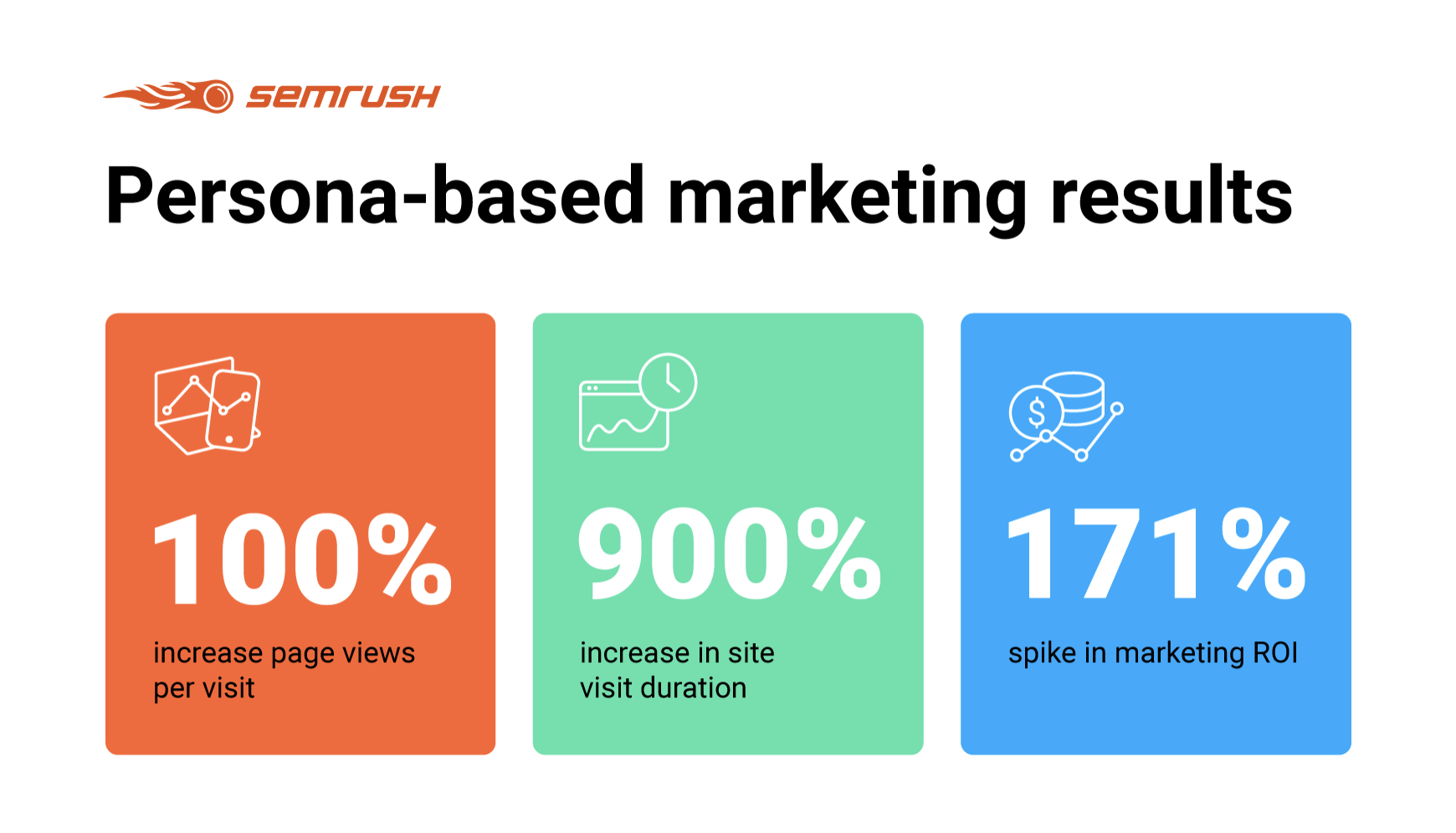
Ideally, you will create several different personas that align with the various audiences that your business targets, building out a profile for each (complete with a fictional name and avatar) across the likes of:
Persona demographics (age, gender, annual income, location, family status, level of education, etc.) Professional status (job title and level, industry and responsibilities) Psychographics (personal and professional goals, beliefs, and values) Pain points and challenges (personal and professional struggles and hurdles to overcome, Irrational/rational fears, and pain points) Influences and information sources (where they consume content online and offline, influencers and thought leaders they respect and follows, and events they attend) Purchasing processes (their role in the decision-making process, lifetime cycle, and purchase blockers)Upon completing this exercise, you should have different personas and a wealth of insight into who these individuals are.
To help out, you can download our buyer persona template and fill this out before feeding this information into your strategy, using it to inform the content that you'll be creating.
3. Conducting a Content Audit
Once you have collected the insights you need on your audience and have set goals and KPIs for your content strategy, it is time to get to work on diving deep into your site's current content performance by conducting a content audit.
Many marketers make the mistake of jumping straight to creating new content as default, but the fact is that almost all sites can benefit from optimizing existing content as the first step.
Just think about it this way…
Every single page of content on your site needs a purpose. After all, if a page isn't serving a purpose, why does it exist?
A content audit can help you to understand how every page is currently performing and allow you to identify quick-win opportunities. And trust us when we say that quick-wins are always a great starting point when executing your strategy.
You can use the Semrush Content Audit Tool to help you to build up a picture of your site's content inventory and give you the data that you need to inform your strategy and make decisions around critical priorities. You can use the tool to analyze your site's existing content based upon data from sources including your XML sitemap and return a list of URLs and associated metrics.
You can either audit your entire domain or break this down by subfolders:
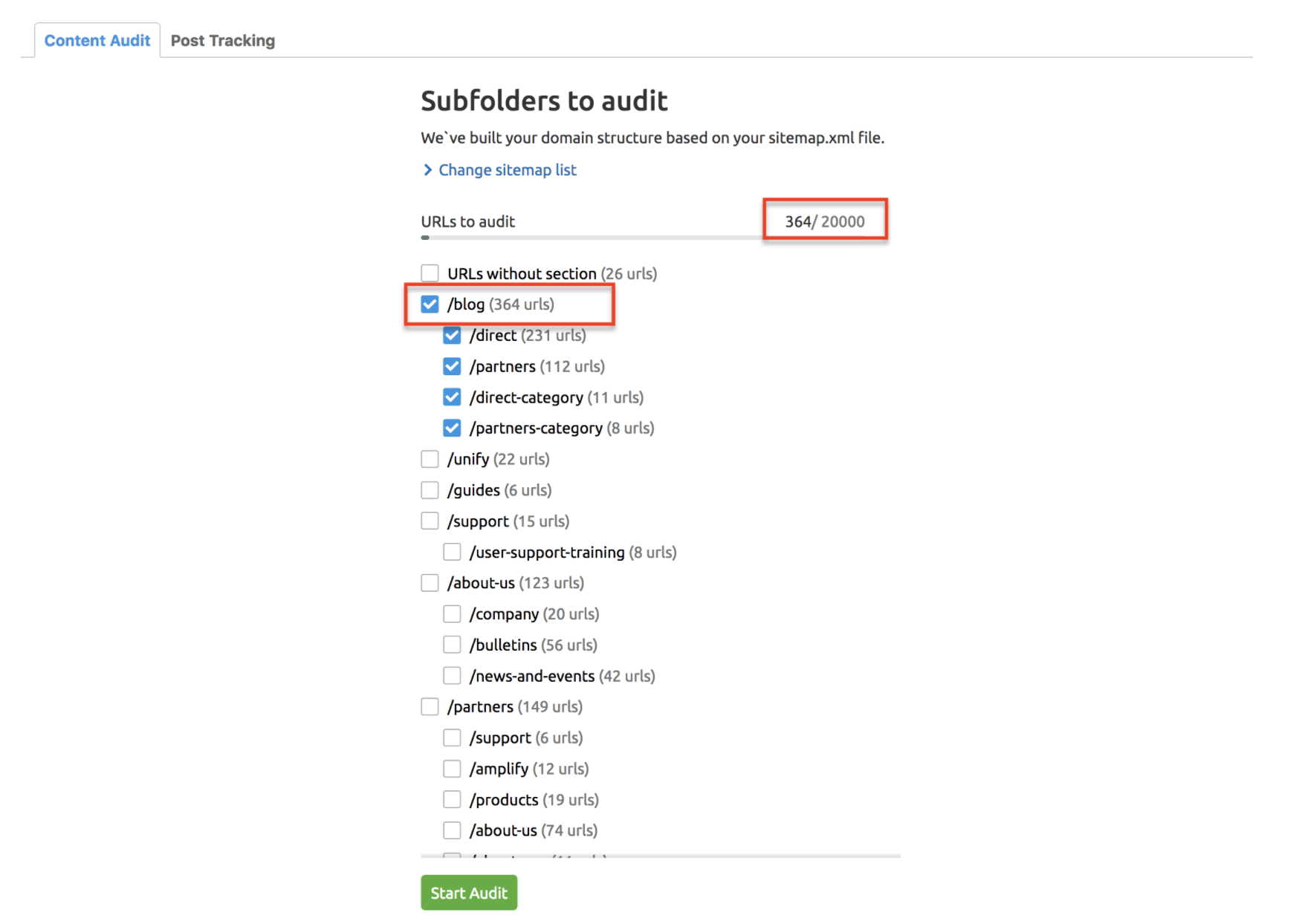
Running a content audit should result in you having an easy-to-understand content inventory that gives you the data you need across traffic, backlinks, social shares, and more so that you can pull out actions.
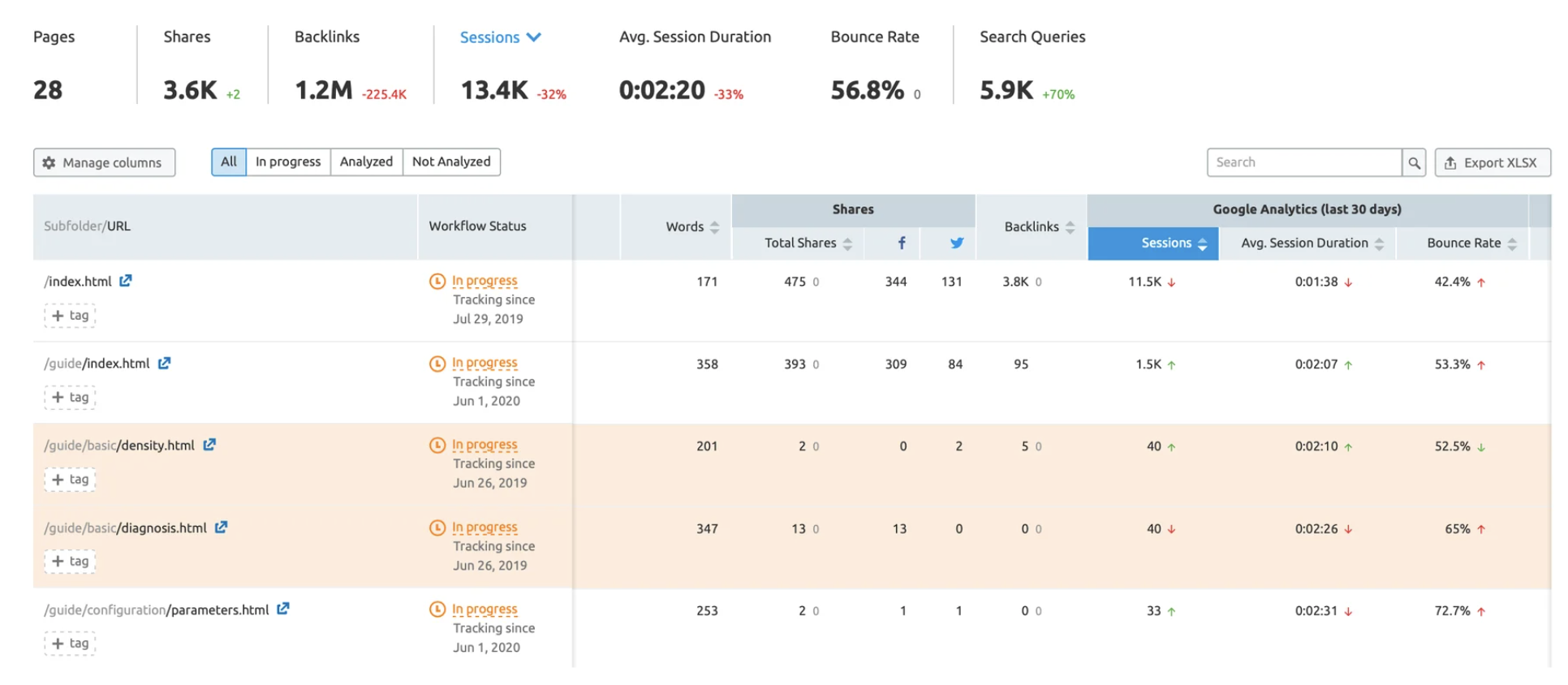
Think of the audit phase as collecting your data into a simple format, and then using it to prioritize your actions. If you do not take the time to run this audit, you will likely rush into the creation of new content too soon and overlook the opportunities that you can act upon to make the content you already created work harder.
4. Prioritizing Optimizing Existing Content
So, now that you have run a content audit and have the data that you need to feed into your strategy, it's time to determine where you should start.
You are going to work through every page on your site (yes, really … if you do not do this, you are not going to see the bigger picture. If you are working on a large site, you can always run this exercise in sections) and assign each page URL one of four actions:
Keep
Improve
Remove
Using this simple but useful framework for turning an audit into actions is the key to finding and maximizing the opportunities.
But let us dig a little deeper to look at what each status means and how to reach this decision.
Keep (Content that is performing well, drives traffic each month, and has earned backlinks)
Improve (Content that is not performing but could be working harder if it was improved or optimized)
Remove (Content that is not currently performing and does not warrant being improved)
The good news is that you can configure the content audit tool to group your site's pages into these buckets based upon criteria that you define:
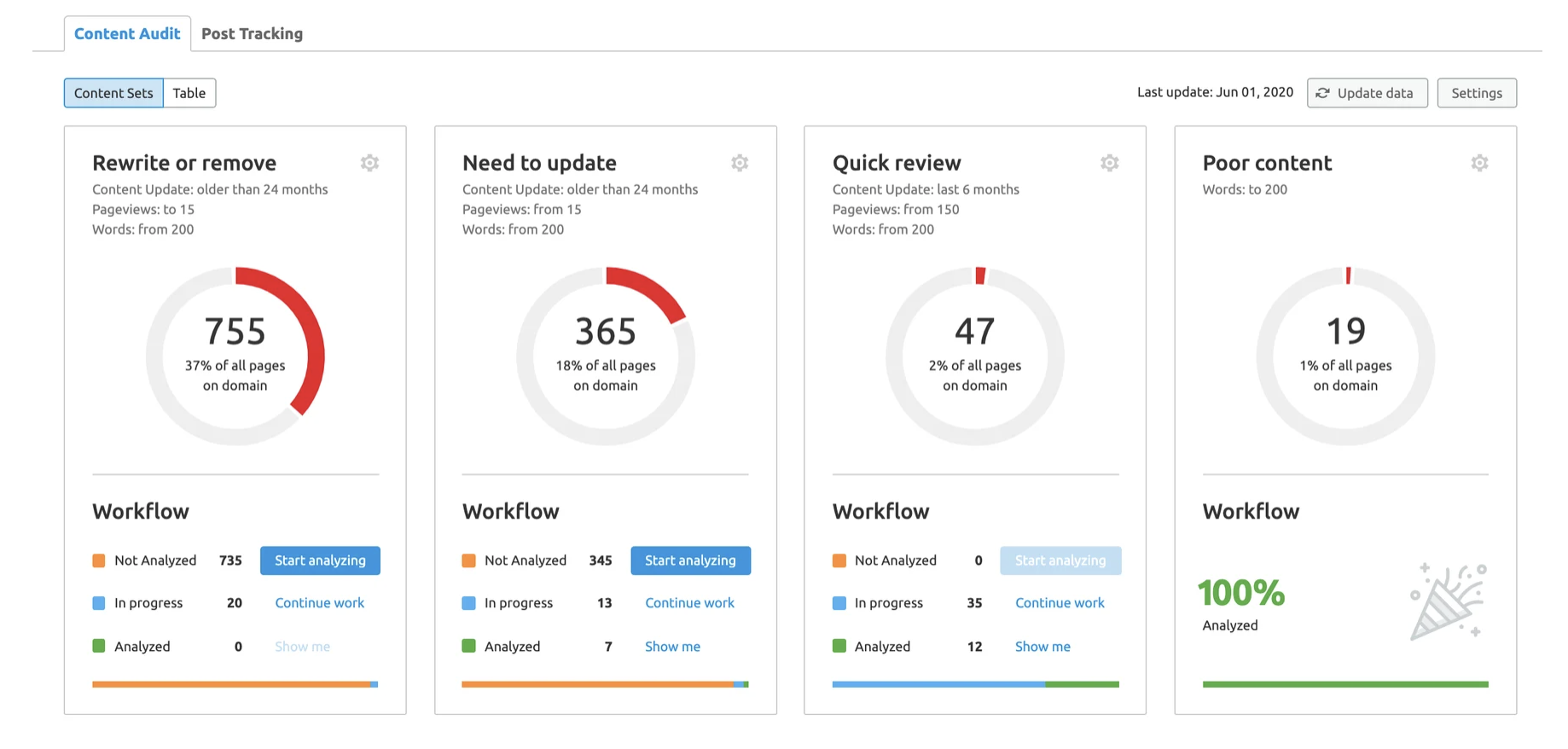
Once you have audited your site's existing content, you should have a list of actions to make these pages work harder.
But when it comes to improving each page, you need to understand why those that are not currently performing fall into this group.
It could be that:
Your page does not dive deep enough into a topic to deserve to rank in a top spot The intent of your page isn't right (see our guide to identifying intent in search to learn more) Your page has not earned enough backlinks compared to the competition You are not targeting the right keywords (or are targeting keywords that you do not have sufficient authority to rank for)A great starting point is to run your pages through our SEO Writing Assistant when you come to optimize the content as a way to help focus your efforts on improving each one efficiently:
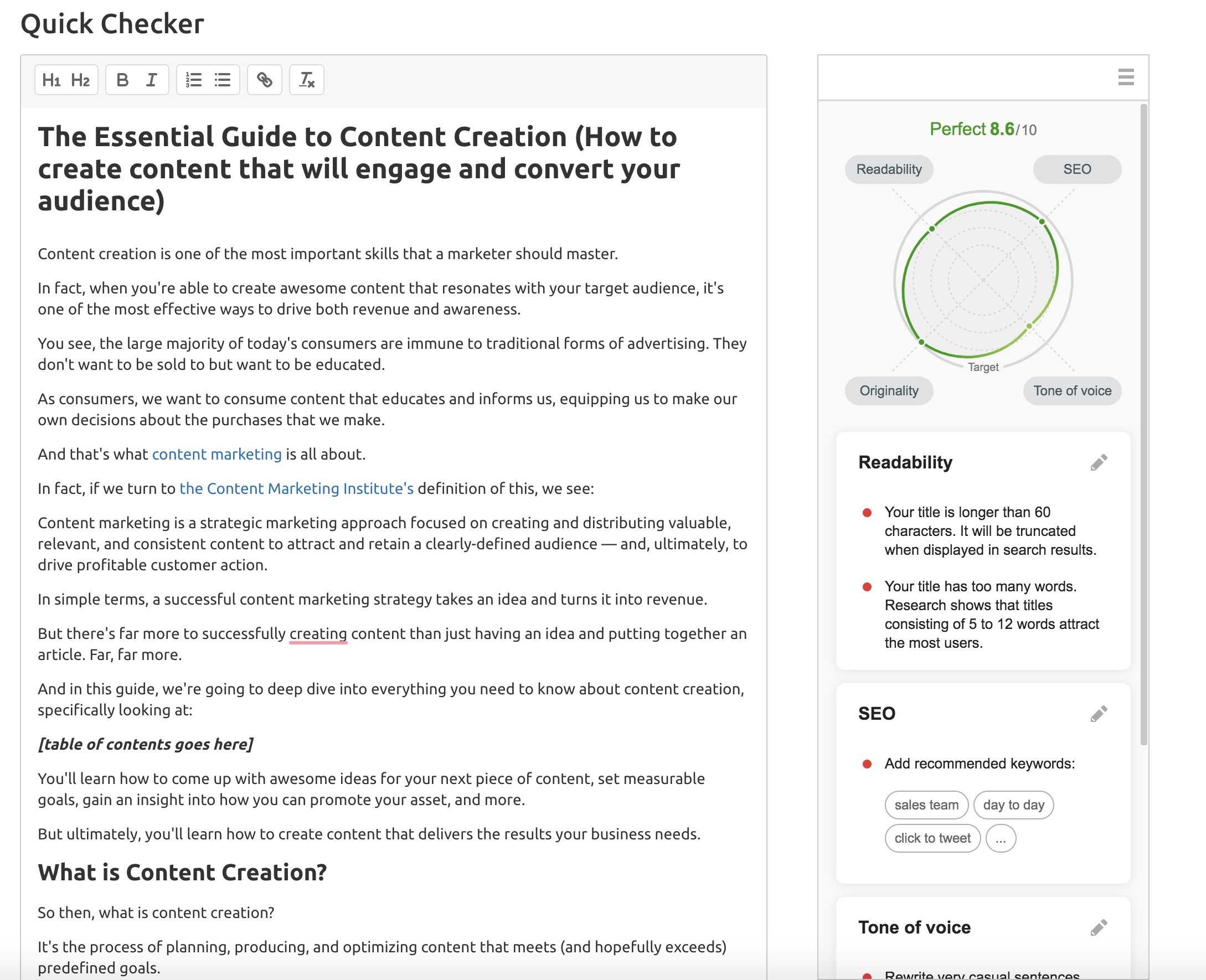
5. Finding Content and Keyword Gaps
While optimizing your site's existing content should play a key role in your content strategy, working with this is only going to get you so far.
Sure, some sites will have more opportunities to improve current pages than others, but every strategy must efficiently balance optimizing existing content with creating new pages and posts. This means that you need to map out opportunities as part of your plan.
You can do this by identifying keyword gaps. Keyword gaps are search queries that your core competitors are ranking for, but you are not currently targeting.
Need help discovering your keyword gaps? Use the Semrush Keyword Gap Tool to help you to do this.
Enter your domain as well as up to four competitors, and you will be able to analyze the keywords that your competitors are visible for but that you are not targeting (filter by the 'missing' tab):
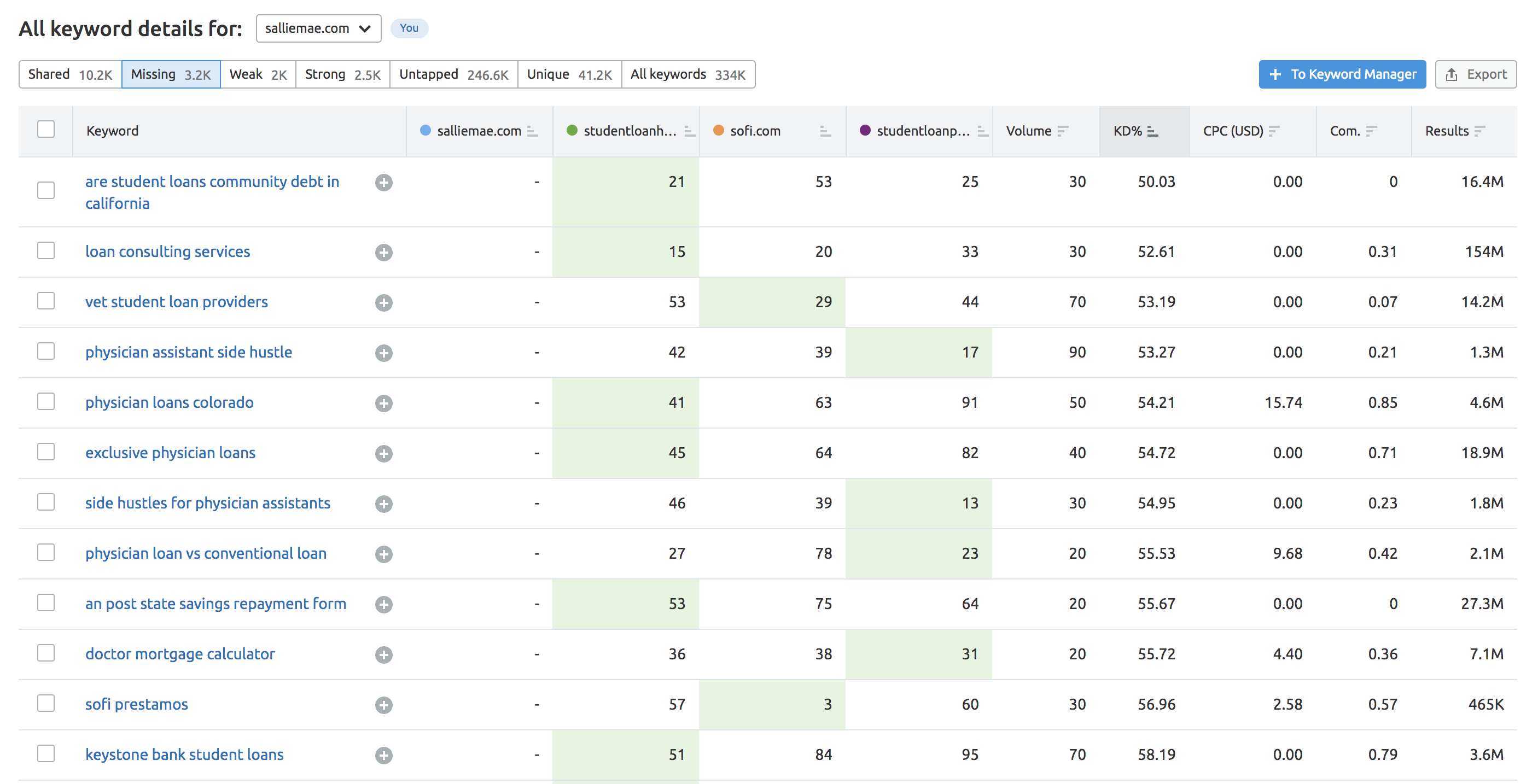
This is a great starting point to help you to build out a strategy that fills the gaps between yourself and your competitors. It also allows you to find opportunities that you have previously missed. However, you'll want to go one further and rely on more than just what your competitors are doing. After all, they might have missed opportunities, too.
We recommend using the Keyword Magic Tool to identify additional keywords to target to build a solid content plan and editorial calendar.
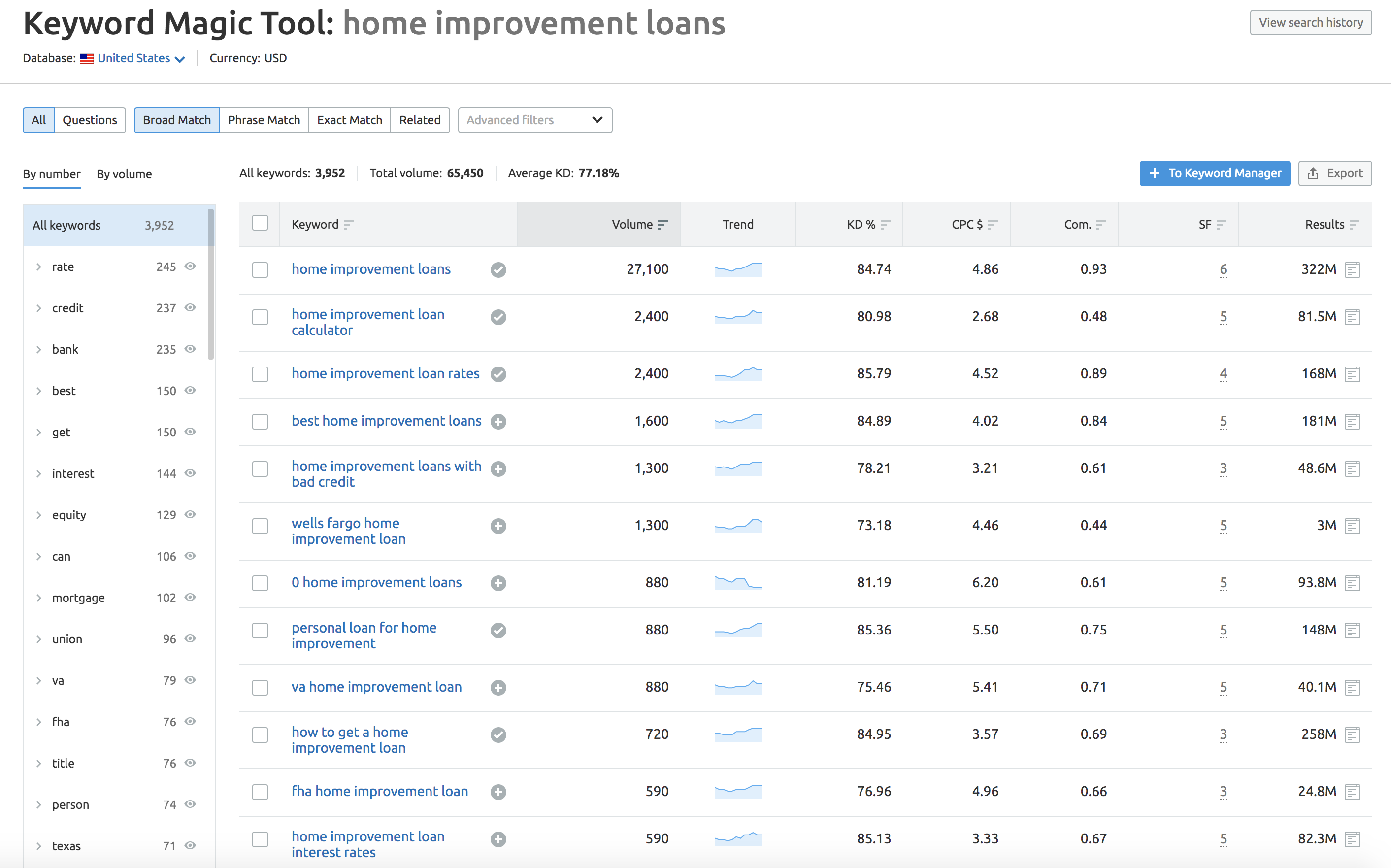
Read our 2020 Keyword Research Guide for SEO to learn more about how to do this and find fresh opportunities.
Lastly, there's a lot of insight that can be gleaned by analyzing your keyword performance. Head to the Organic Research Tool and open up the 'positions' tab.
Here, you can find a list of all of the keywords that your site currently has visibility for. We recommend filtering for positions No. 6–No. 20 as this shows keywords that are within striking distance of placement within the top 5.
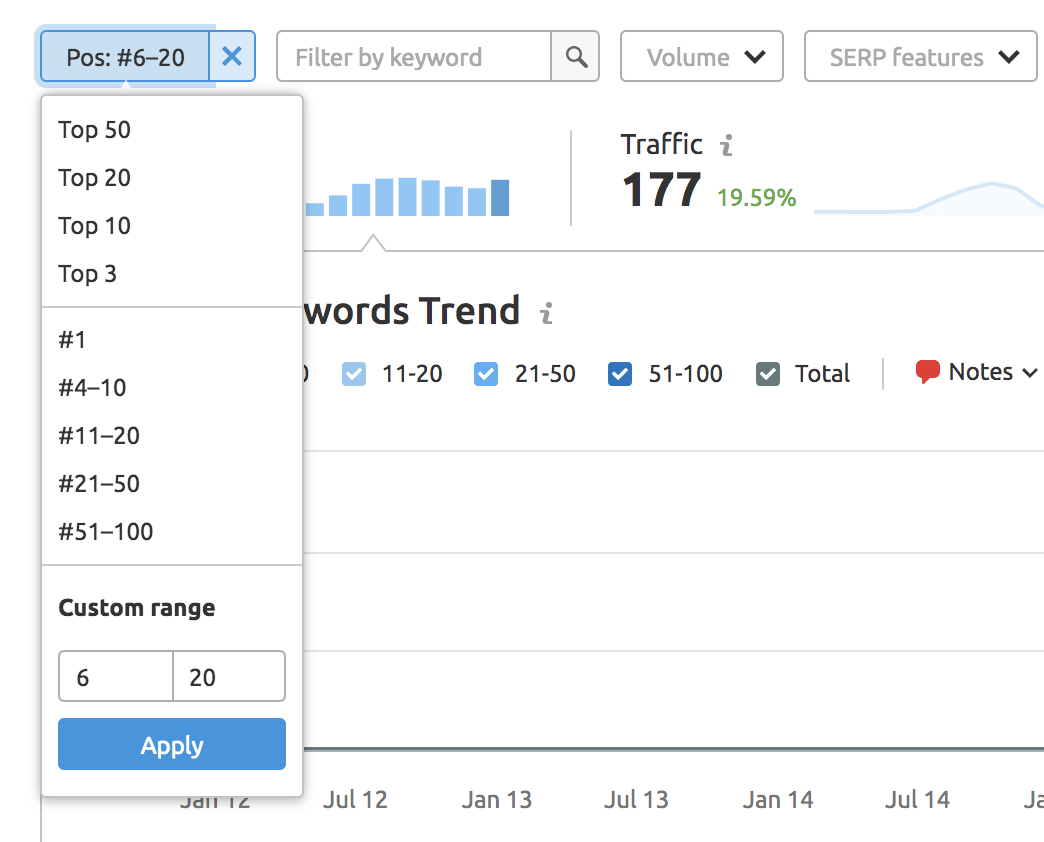
You can analyze keywords that you are visible for against the page that's ranking, looking for keywords that do not closely match the intent or content of the page.
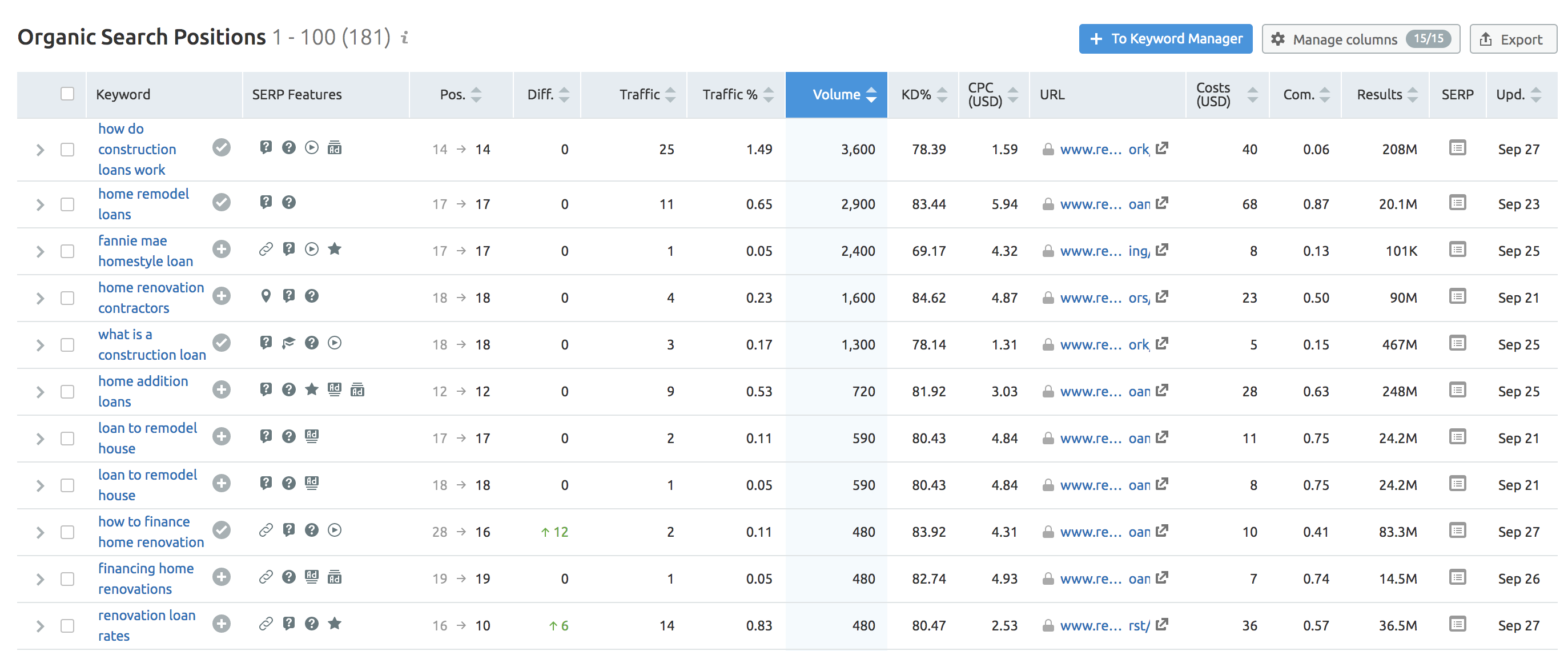
You can find opportunities to target specific search terms by creating highly relevant content and adding internal links from the original page that's visible.
6. Planning New Content
Once you have identified keywords and topics for your new content, you need to take the time to plan these pieces properly. It is often the case that content is prepared and written by different people. A solid plan is an effective way of communicating the needs of a piece to a copywriter that they can reference during production.
And this comes down to two things:
Analyzing and understanding search intent Building out content frameworks that a copywriter can followAnalyzing Search Intent
You need to know the intent of the content that's already ranking to create a piece that competes. This can come down to analyzing the pages that rank in the top 10 positions for your main keywords.
Head to Google and search for your primary keyword. What's the intent of the pages that are ranking? These could be:
Transactional Informational NavigationalFor example, if a searcher intends to find information, you would struggle by attempting to rank an eCommerce category. Likewise, if the intent of a searcher is transactional, you will not need to create that 5,000-word guide you have been considering.
Looking for another real-world example? Let's look at the data behind a search for the term' finance internships.'
This term is searched for 6,600 times each month. It's clear why you may be considering targeting this keyword.

Now, we will head to the SERPs to find out what's ranking:
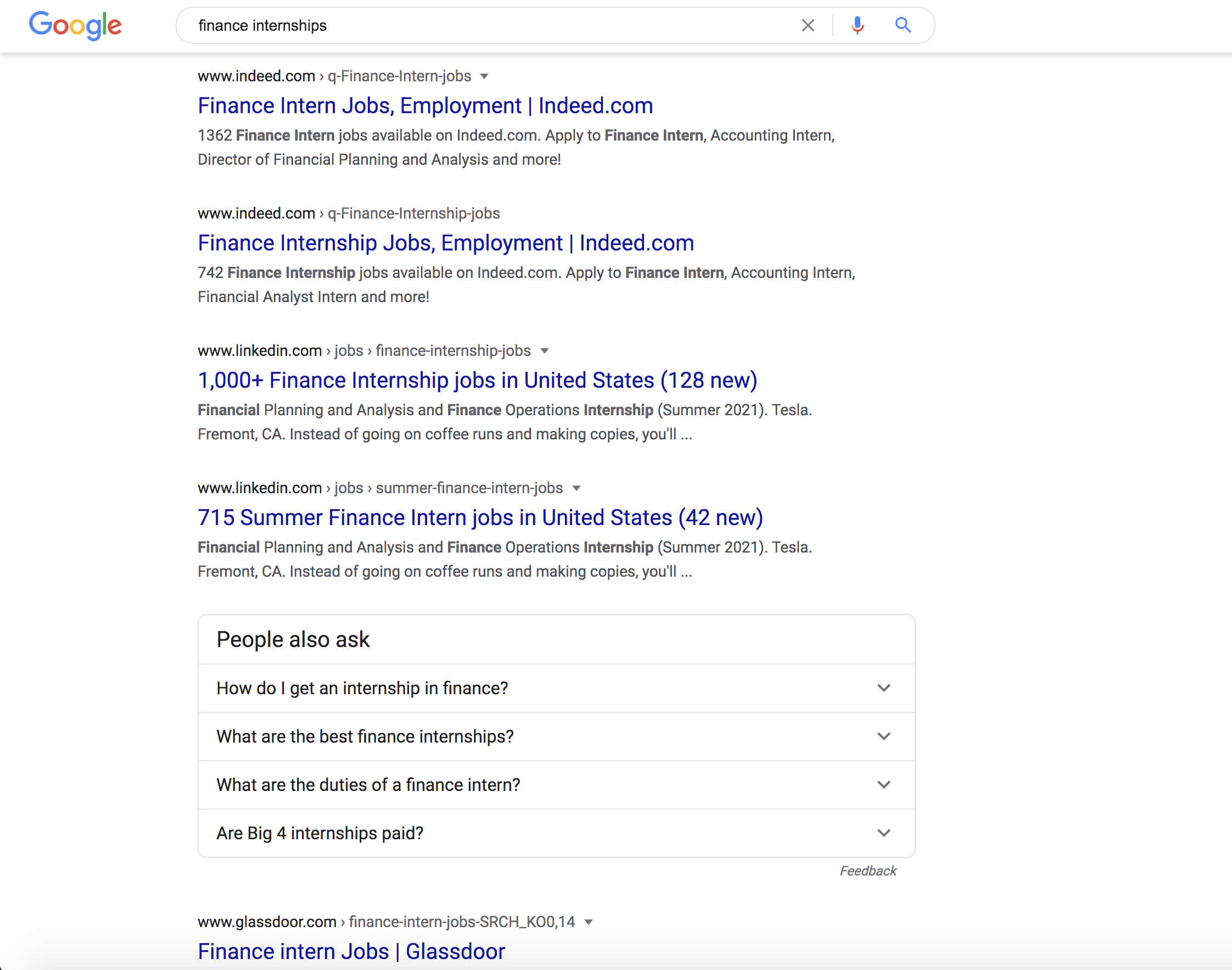
That the intent of a searcher who is entering this keyword is to find an internship, if you want to rank for this keyword, you are going to need a list of live internships that can be applied for, not a guide that details the process.
Be sure to analyze the intent of the keywords you will be targeting in your content so that you can use this insight to steer the format and type of page you'll create.
Building a Content Framework
It always helps you be able to provide a copywriter with a framework for every piece of content that you are asking them to create so that they have the insights needed around things such as:
Your primary keyword(s) Secondary keywords Optimal word length Terms to include in the title and meta descriptionYou can use the Semrush SEO Content Template to quickly and effectively produce frameworks that your copywriters can work from to produce optimized rank-ready content.
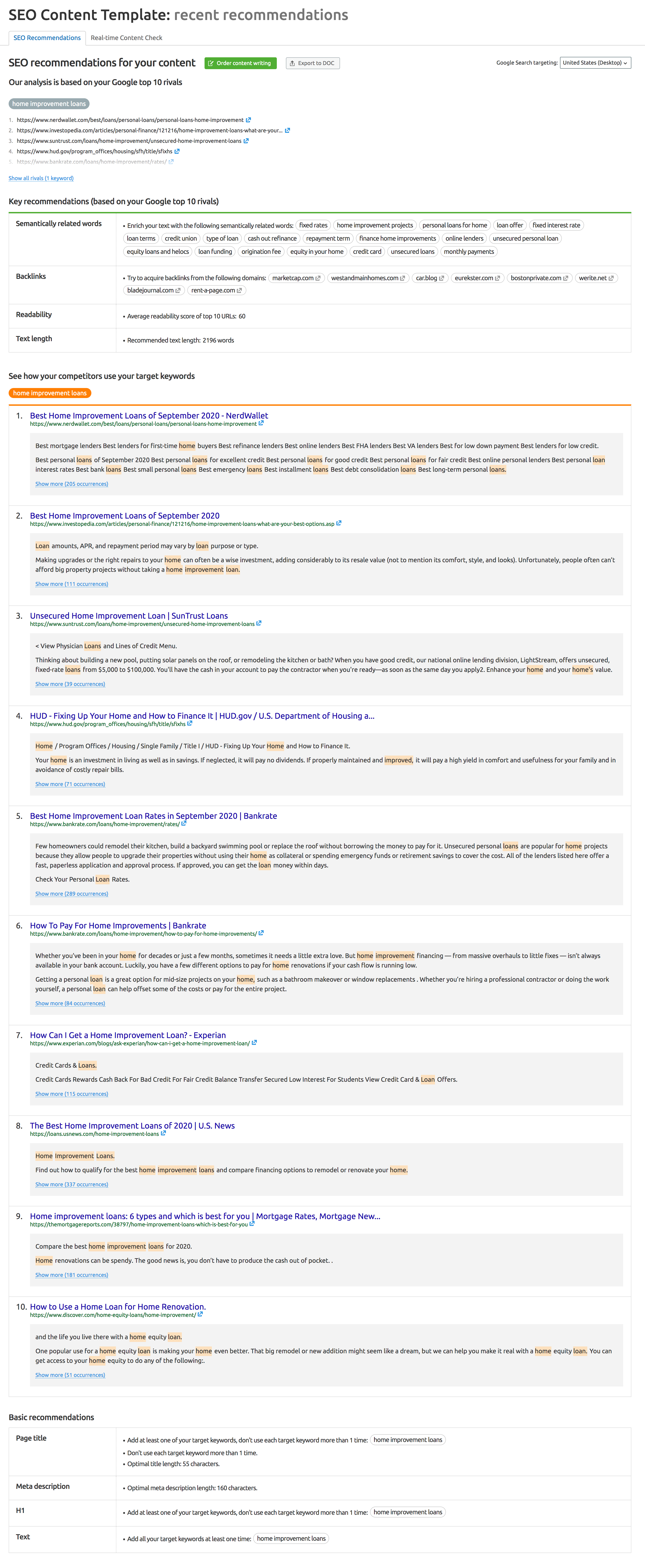
7. Crafting a Content Distribution and Promotion Strategy
Unless you promote your content, it is unlikely that your efforts will result in a roaring success. Despite what many might claim, very few businesses can publish content and see these pieces perform without an effort taken to distribute and amplify them.
According to the 80/20 Pareto Principle, you should be spending 20% of your time on content creation and 80% on promotion.
It might sound crazy, but it works.
If no one knows about your content, how can you expect them to take action from it? How will you drive traffic to your pieces? It's simple; you won't. Or, at least not for a while.
There are hundreds of ways you can promote your content, but you need to be mapping out your approach to distribution as part of your strategy.
Popular and effective ways to distribute and promote your content include:
Sharing across social media Collaborating with influencers Running paid social media ads Including in your email newsletter Email outreach Sharing on platforms such as RedditCheck out our guide on content promotion hacks and tips from experts to arm yourself with a whole host of ideas that you can use to promote your next piece.
In this, we asked several industry experts the all-important question of:
Is there a possibility that unique content will promote itself? Why?
Take a read of the guide to see the answers for yourself, but the consensus is that you will need to put in the effort to promote every piece if you want to see the best results.
8. Measuring Success
You started creating your content strategy by setting goals, and now you will end it by mapping out exactly how you're going to measure the success of each piece that you publish.
Now, so long as you set S.M.A.R.T. goals, you should already have a pretty good idea of how you will measure the performance of your content, but this will typically tie back to the goals you set.
We recommend setting weekly intervals to measure performance, always analyzing back against the goals you set out, and recording the progression against the time-bound metric you put in place.
Did you set a goal of doubling organic traffic within six months?
Weekly, you would want to measure the metrics related to this (organic hits, impressions, and ranking positions, as an example) and showcase where things are now against both the benchmark point and your end goal. A weekly check-in on performance also helps you to make changes to your strategy should you need to do so, based upon the results you are seeing.
Putting together a solid content strategy is all about building solid foundations. Without it, your efforts will be wasted. Take the time to get your strategy right, but do not feel you need to reinvent the wheel every time.
Follow our proven template format that we have shared above, complete the content strategy template, and you will see that creating a content strategy can be based around a tried-and-tested approach that works hard to drive results time and time again.Innovative SEO services
SEO is a patience game; no secret there. We`ll work with you to develop a Search strategy focused on producing increased traffic rankings in as early as 3-months.
A proven Allinclusive. SEO services for measuring, executing, and optimizing for Search Engine success. We say what we do and do what we say.
Our company as Semrush Agency Partner has designed a search engine optimization service that is both ethical and result-driven. We use the latest tools, strategies, and trends to help you move up in the search engines for the right keywords to get noticed by the right audience.
Today, you can schedule a Discovery call with us about your company needs.
Source:





